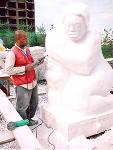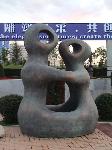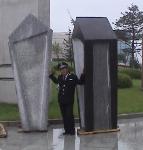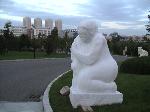- Getting around Lijiang. Dont stay in the Old Towns more than 2 days, there is nothing to do. KRISS Oct 9, 2013 05:46
- 2013 Beijing Temple Fair BENNYLAU Feb 26, 2013 03:29
- Malaysian traveling from KUL - LAX vis Shanghai PVG ZATI_DY Jan 3, 2013 20:15
8th Changchun International Sculpture Symposium
- Views: 14108
- |Vote: 3 1
- |Add to Favorites
- |Recommend to Friends
The 8th Changchun China International Sculpture Symposium 2006
Since its inception in 1997, the themes Friendship, Peace and Spring continue to flourish at the Changchun World Sculpture Park, as 47 sculptures by 48 sculptors from 45 different countries are unveiled.
On 3 September 2006, sculptors and ambassadors from around the globe, gathered under pouring rain to partake in the celebration of three significant events that were cleansed and blessed by the celestial waters. The 2008 Beijing Olympic maquette proposals from countries around the world; exhibitions by Chinese sculptors Wu Weishan; father and son Yuxian and Cheng Bing; and the 8th Symposium Closing Ceremony.
Sculptors from Faro Island to the Bahamas, met for forty days at the World Sculpture Park Studios in Changchun
China to enlarge their proposed maquettes. For many, this was a unique opportunity to expand the dimensions of their work in sizes that were not economically and feasibly possible before. The sculptures in clay were reproduced in fiberglass then painted to replicate the patinas that met the artists' exact specifications. After a few days on display they will be shipped to Dalian, a beautiful port city south of Beijing, where they will be casted into bronze. They will be prominently placed in the World Sculpture Park upon their return.
Sculptures that were ready for permanent installation are: The Whale, by Trondur Patursson of Faro Island, executed in stainless steel. Gate of Time, in plate steel by Nenad Vacic of Serbia. Sarajevo Heroes, in granite and glass, by Mensud Keco of Bosnia & Herzegovina. The Harvest, in granite, by Ri Il Myong of North Korea. Soba, in pink marble, by Antonio Magina of Angola. Bread Winner, in basalt, by Michael Khumalo of Malawi. Night and Day, in Basalt and granite, by Sreten Milatovic of Montenegro. Mother and Son, in white marble, by Claude Montes of Haiti.
Her Mother
As space is limiting how much that can be said about this great symposium, I will focus on a few pieces, along with some statements from the sculptors' own views about their work and aspirations. Randomly selected are the sculptures that follow:
Her Mother, an abode where children can play. A sort of refuge, as safe as a womb where one feels like the embryo within. A safer place than the outside world . The mother and child do not see eye to eye, but yet they see the same world from their lateral eyes, oblivious to its chaos and qualms. Sculptor Elkana Omweri of Kenya, East Africa, describes his sculpture Her Mother "as an example of a permanent bond between child and biological mother. This bond is forever. The most unchangeable phenomenon in the life of a parent and child relationship; at whatever age or circumstance, the mother figure is an ever present factor. The open spaces between arms and legs and hands, represent the world, the universe, the womb, the unknown, and the mysterious." For Mr. Omweri, "future projects will follow the directions taken by Her Mother, both in volumetric space and surface treatment. As a direct carver of stone and wood, I have never worked in clay before. Bronze is new to me, and fiberglass is introduced to me for the first time as a sculptural medium. This work has opened my eyes toward new directions that I hope to fallow in the future."
A Samoan Talking Chief
A Samoan Talking Chief by sculptor Taimalelagi Penehuro.
In Samoa the talking chief speaks on behalf of disputing parties in civil cases and presides over wedding ceremonies. In the latter case only one talking chief is necessary. In the former, there are two talking chiefs and two or several sitting chiefs. The talking chief stands with a large stick and upholds the last word. He makes the final decision. Though less powerful than the sitting chief, many revere his sense of wisdom and authority. Mr. Penehuro explains that "the Talking Chief is the deliverer of peace and integrity. He conveys the seriousness and importance of decision making." Mr. Penehuro says that his work, following the symposium will be different. He will venture in the territory of stain glass figures in three dimensions. The Samoan Talking Chief was truly his greatest achievement, based on the given time. "It is an important part of my life." He only wishes that he was able to create another set of talking and sitting chiefs, in order to complete the dialogue.
Night and Day
Night and Day comprises of two sentry-like boxes, reminiscent of guard shacks or check points at demarcation lines between countries. Night is carved from a solid piece of 2.5 meter basalt, Day is contrastingly a gray granite of the same dimension. They form a balance with Zen-like quality. Every ounce of energy and time was espoused in their execution. Montenegro sculptor Sreten Milatovic, diligently worked with unrelenting prowess under the August sun and occasional rain. During pauses in my work across the field, I would grab my camera to photograph his meditative gestures and arduous momentum. He gradually revealed the coffin-like forms that invoke the memory of mausoleums and death.
Night and Day stand stoically side by side at arms? length, as silent reminders of guard houses that stand between boundaries. One house for entering and the other for leaving and vice versa, depending upon one?s own direction. They must coexist as good and evil, as night and day, as two sides of the same coin. The four cavities on the sides of those two imaginary houses are like doors that lead to the four corners of the world. They remain imaginary passages that are impenetrable, as fates that are permanently sealed in stone; no longer effectively useful portals or barriers that stem the flow of humanity.
Child Adoption
On several occasions I was able to ask Solomon Island sculptor, Frank Haikiu, some questions in regard to his use of iconographical symbols that adorn the base of his totem-like sculpture, Child Adoption. I was also intrigued by the duality of the figures that share a singular body. A similarity that is found in several of my own work in wood and stone. It never ceased to amaze me about how much sculptors share in common. No matter how distant may our lives be, our feelings and creativity seem to radiate from the same cosmic source.
According to Mr. Haikiu, "Child Adoption marks a new relationship; an acceptance of responsibility, with care and love for a child apart from the obligation of the natural child. Peace can be achieved if we put others first; give more and ask less; respect others and the adoption of good qualities will lead the way to peace. In presenting my ideas, I am very mindful of egoism. I must satisfy my self with a good finish. The viewer is free to criticize or admire. ...I am a wood and stone carver who also paints. I wish not to discuss my vision as far as future works are concerned after the symposium, as they may not happen!"
Bread Winner
Bread Winner by Michael Chipole Khumalo, symbolizes the innate love of life and family of all living beings, be it human or animal. The bird as bread winner, "collects seeds from the field to feed its family - the shared meaning of its love. In every society there are those who struggle to survive even when resources are limited and few. People, like this bird, scavenge to make ends meet."
Colorfully sparkling marbles were incorporated into the basalt, around the collar and chest of the bird, forming a colorful garb that resembles and Ashanti-like cloth from the Malawi region of South Africa where Mr. Khumalo originates.
As for the future, Mr. Khumalo intends to continue to work in lager scale which can be accomplished with the use of electrical tools that "I have never used before!" Like many of the stone sculptors, Mr. Khumalo, prior to this symposium, had only used the slow and tedious methods of hand carving that limit one?s creativity to smaller works.
Serpent
I was physically moved by the posture of The Serpent which looks more like a mermaid from the sea than the reptile that it represents. Mr. Eduardo Pereira Bassali of Guinea-Bissau was a bit reserved when it came to disclosing the motive of his sculpture. To my perception it seems to be filled with Egyptian Iconographical meaning. An Ibis for instance, graces the forehead of the female serpent in a harmonious balance. It conforms to the desires of the serpent in a confluent flow between its beak and the hypothalamus of the serpent. Like a symbiotic parasitical relationship. I was spiritually taken by this magnificent composition and the dynamic balance between bird and man.
Gate of Time
Gate of Time by Nenad Vacic, presents a juxtaposition and interplay of geometric shapes that invoke the movement of a working apparatus. Synonymous with the representation of magnified parts of machinery that one observes in Russian Constructivism. A working machine that momentarily pauses in time, long enough to allow observation and interplay. Children were observed as they attempted to pass through the Gate of Time. It will remain a portal between worlds; not easily penetrable, a mild obstacle that demarcates a boundary between this side and the other. A symbolic barrier that is not connected to a fence or wall, perhaps an imaginary barrier that disappears with the passage of time.
The Village Musician
The Village Musician, by Isaac Ntwayagae Chibua, is based on the South African village musician Ratsie Setlhako, of Botswana. He played a single stringed instrument called a Segaba. Like a violin, this instrument is played with a bow. Before the sculpture was completed I commented about the bow and the string not being taut. The sheer need of adjustment gave them a sense of over use and tiredness, as if at the stage of an accomplished mission. Perhaps a well deserved rest form a served duty. Before his untimely death in a car accident in 1975, Ratsie played for anyone who was willing to listen and some times for his own enjoyment in the absence of an audience.
Mr. Chibua places the musician in a melancholic pose. He balances him on a single leg, the other leg braces the stance in a playful dance gesture. Mr. Chibua softly states that "singing prolongs life and prevents death!" The Village musician is captured in his last stance, playing his Segaba and singing his last song, "Let's Change" which I had the pleasure to hear on the Botswana embassy of China web site.
The Window
The Window by Nicaragua's Mimma Salinas, is a very dramatic composition in its own right. Like the previous portals and gates without fences or walls, this window suspends in mid air unattached to a home; it offers no point of reference, but only suggests the female subject's desire to flee in or out this open opportunity. The arms that helplessly prevent her flight, upon close observation, can only belong to two different persons. Their anatomical structure classify them to be masculine.
We flew together from Beijing to Los Angeles, Mimma and I, but it was not the appropriate moment for her to comment about her work or as she puts it, "I don?t even want to think about it right now!"
After giving birth to such a gigantic masterpiece, her energy level was physically depleted. I did not want to psychoanalyze the piece without hearing first hand her own opinion which I wanted to postpone until the work was totally finished. There are as well the subconscious actions that intentionally or unintentionally appear beneath the surface of a work of art that engage the viewer to decipher one's own meaning at different moments and times. Those moments may vary from season to season and from sunlight to darkness. This is surely a Window into the unknown that beckons further exploration.
Mother And Son
Mother and child is a recurring theme in the World Sculpture Park. Mother and Son was created with the assiduous assistance of Mr. Chen, with whom I communicated through sign language and drawings. Ms. Zhang XiaoXu, my interpreter, was very helpful when verbal communication was necessary. We learned a lot about each other during those few days, and parting brought to our eyes many tears. I became speechless at the airport when Ms. Zhang said, since she will no longer see me she will find comfort in visiting Mother and Son at the park. Those were the fondest words that had ever been said about my sculpture. It stands as a silent tribute to my mother Josephine who recently passed away and to my twin brother Joseph who also left this earth at the prime of his life. Mother and Son commemorates the unity between mother and child. They permanently unite in an eternal embrace, no longer having to long for each other's presence. They are in each other's thoughts, in each other?s spirit, in each other's psyche. They are united in life as well as in death. Their memory is only a living reminder that they once existed upon this earth. As their bones decay in real time in the ground below, many miles away in a distant continent. We can celebrate life by immortalizing it in stone, but the inevitable truth remains a temporal phenomenon that recurs in cycles that may terminate in the absence of "Friendship, Peace and Spring!"
World Sculpture Park lives up to its standards
The beautifully manicured and landscaped 92 hectare World Sculpture Park lives up to its standard. It can legitimately boast the presence of sculptures from all around the globe. During stone carving at the 8th Symposium, I would often skip lunch in exchange for a long walk in certain segments of the park until I covered its every square inch. Photographing as I saw fit, many pieces under different light and weather conditions. The rays of the sun at noon were usually veiled by a thin layer of condensation that rose from the humid northeastern elevation. Great lighting for photography at any time of day.
Prior to the opening of the World Sculpture Park in 2003, the sculptures created at the previous symposia since 1997 were displayed at Shengli Park. A smaller venue adjacent to the Song Yuan Hotel where we spent a greater portion of the forty days. A few of us ventured into Shengli Park, passing under the colossal monument of Chairman Mao Zedong at 4:30 every morning to join the Changchun locals for the 5:00 am sunrise Tai Chi sessions. Quite an awakening experience that proved as the days progressed, to be very enlightening.
I will miss the warmth of the people of Changchun, the great dumplings with tea, corn on the cob, and watermelon. Most of all I will miss going to the World Sculpture Park studios to tackle a piece of stone, in such an energetically invigorating and inspiring environment.
Many many thanks to the People's Republic of China and especially the enchanted city of Changchun for inviting me to the 8th and final symposium. Your warmth radiates like "A red sun in the center of" my heart* ..."At life's full flowering"!**
* A red sun in the center of our hearts, refers to Chairman Mao in posters and music.
** At life's full flowering: is a line from a 1925 Mao Zedong poem, Chang Sha.















 Copyright © 1998-2025 All rights reserved.
Copyright © 1998-2025 All rights reserved.